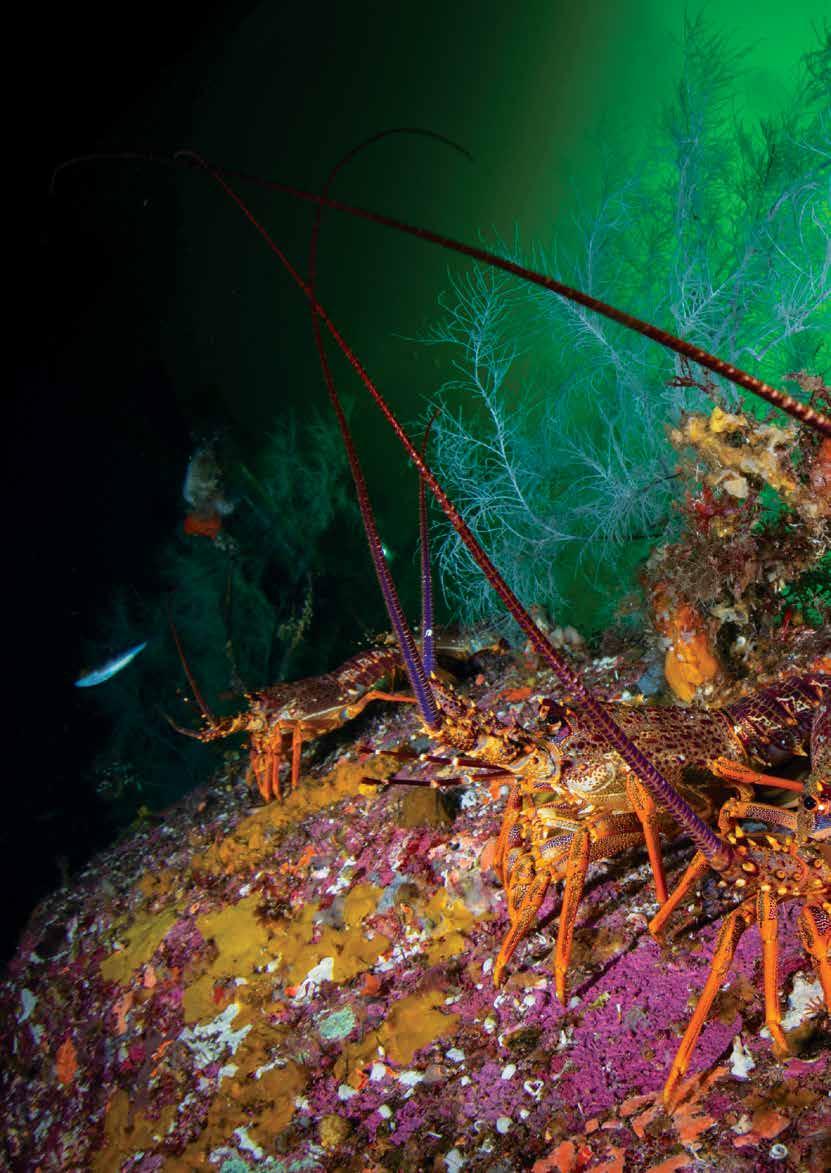
14 minute read
Caring for our unique biodiversity
by NIWA_NZ
ENHANCING BIODIVERSITY PROTECTION
• Improved understanding and quantification • Innovative approaches to ecosystem monitoring, protection and management • Tools and products for sustainable management and restoration
Advertisement
RESTORING DEGRADED AQUATIC ECOSYSTEMS • Identify and quantify environmental stressors • Tools and strategies to restore and rehabilitate • Tools and strategies to reduce the impact of extractive industries such as fishing and mining
PROTECTING AQUATIC ENVIRONMENTS FROM INVASIVE SPECIES
• Understand emerging threats and develop best practice management • Models to predict future impact of aquatic pests • Strategies for eradication and control of established pests

Biosecurity surveillance in ports and marinas
Divers Louis Olsen, Lily Pryor Rodgers and Andrew Miller prepare for a biosecurity survey dive in Bluff Harbour (Awarua). [Chris Wood] For the last 20 years, MPI has contracted NIWA to deliver the National Marine High Risk Site Surveillance programme every six months in 12 of New Zealand’s busiest shipping ports and marinas. Many of these sites are the first entry point for international vessels and where incursions by marine non-native species are most likely. The surveillance aims to detect incursion of high-risk, non-native organisms – those listed on the national register of Unwanted Organisms or those that have not previously been recorded in New Zealand. It also detects range extensions by established organisms that exhibit characteristics of pests. Sampling within each survey site is focused on the habitats and locations where target non-native species are most likely to occur. Over the last two decades, the survey teams have completed 34 (biannual) rounds of surveys and sampled more than 90,000 locations for marine non-indigenous species. Their surveillance has detected 26 new-to-New Zealand marine species and 195 range extensions of marine nonnative species known to be in New Zealand waters. Some of these detections resulted in biosecurity responses from government agencies or regional authorities in attempts to delimit or eradicate pest species.

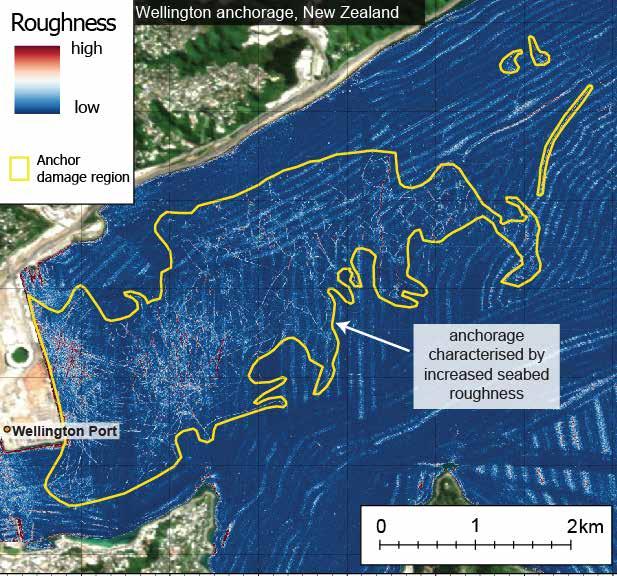
Anchors cause extensive and persistent damage to the seafloor
High-resolution mapping by NIWA, University of Auckland and Auckland University of Technology researchers has produced the first-ever global estimates of coastal habitat damage caused by anchoring. The COVID-19 pandemic resulted in port congestion around the world, leading to unprecedented bottlenecks in maritime traffic and intensive anchoring of hightonnage ships – and seaborne trade is predicted to quadruple by 2050. To understand how the increase of hightonnage ship anchoring will affect coastal marine ecosystems, the scientists combined information from high-resolution seafloor data, real-time ship tracking information,
Seafloor data from Wellington, collected in 2007 and 2008, showing increased seafloor roughness in the anchoring region. (The background satellite image was obtained from Toitū Te Whenua Land Information New Zealand (LINZ)). [NIWA]
scientific literature and news media. For the first time, they demonstrated that anchor damage on the seabed is severe, long-lasting and widespread, with the area of damage increasing with the number of ships, and the impact with the duration of anchoring. In Picton, high-tonnage ship anchors excavate the seabed by up to 80 cm, displacing enough sediment to fill an Olympic-sized swimming pool, with impacts lasting for at least four years. Scaling these results worldwide suggests ship anchoring practices are a global driver of seabed damage, because the calculated volume of sediment displaced by a single high-tonnage ship on anchor can reach a volume of 2800 m3 .
Protecting our taonga together
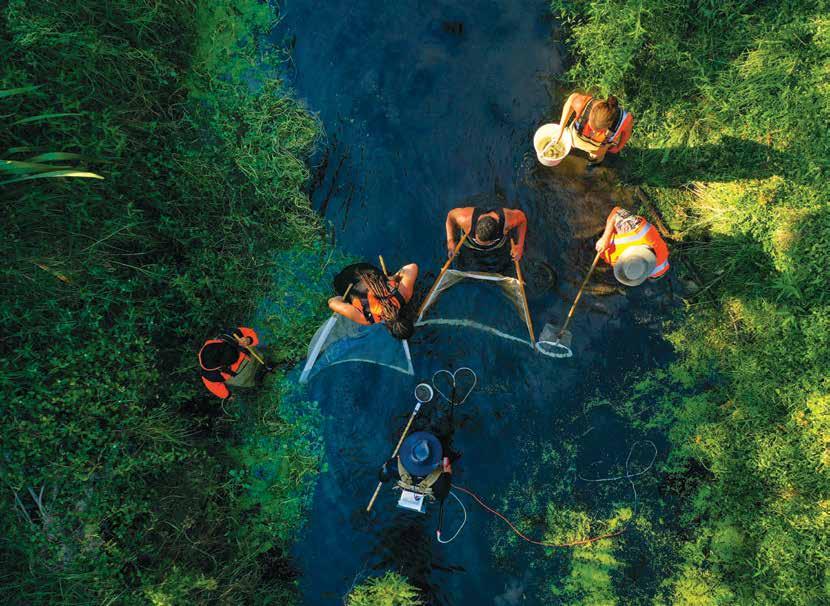
Over the last decade Ngā Kaitiaki o Ngā Wai Māori (NKoNWM) have been working with Northpower, NIWA, the Ministry of Primary Industries, the Department of Conservation and other agencies to move juvenile eels (elvers) over the Wairua Falls Power Station as they swim upstream during part of their life cycle. To test the success of the trap and transfer programme, each autumn NKoNWM and NIWA investigate how the elvers that were moved over the power station are surviving. The annual survey involves catching juvenile eels in streams connected to the Wairua River to assess their numbers and distribution. The eels are identified by species, measured and then promptly returned to the stream. The survey is one of many projects within the Cultural Keystone Species research programme, where mana whenua undertake the fundamental research required to inform their unique responsibilities as kaitiaki. Before the Wairua River elver surveys began, very little research had been undertaken nationally to help explain what makes stream habitats suitable for elvers to thrive. This multi-year survey has significantly improved understanding of the factors that affect the survival of juvenile eels and what habitats are good for tuna.
NIWA staff and members of the seven hapū of NKoNWM search for tuna by use of electric fishing. The tuna are returned unharmed to the stream after the assessment. [Rebekah Parsons-King]
Co-management and restoration of our freshwater taonga species
The Cultural Keystone Species was a four-year (2016–21) MBIE-funded research programme that built on the freshwater taonga species research that NIWA has been undertaking with whānau, hapū and iwi around the country over previous decades. The programme included interlinked studies centred around understanding what causes stress to freshwater taonga species throughout their life. It has co-developed research methods, tools and products with whānau, hapū and iwi that inform new and innovative management approaches for the protection, restoration and economic development of taonga species such as tuna, kōura and kākahi. These include significant advances in understanding the water quality and habitat needs of juvenile tuna, kōura and kākahi, and new methods for understanding the state and trends in populations that are directed by mātauranga Māori and informed by hapū-driven datasets. The programme supported at least 30 researchers working in partnership with 20 hapū/tribal entities, seven consultancies, two power companies and 15 regional and central government agencies. In collaboration with the University of Waikato, the Cultural Keystone Species team also supported five graduate students and three summer research scholarship interns through a variety of practical experiences, including developing strong professional networks and gaining an understanding of the importance of partnerships between hapū/iwi, agencies and research providers.
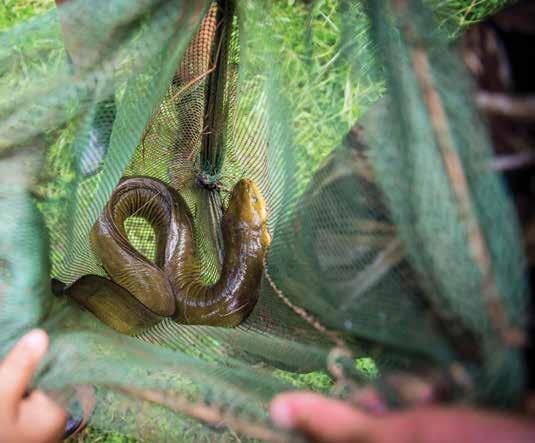
Freshwater species such as tuna, kōura and kākahi are central to the identity and wellbeing of many Māori communities throughout New Zealand. [Stuart Mackay]
NIWA PHOTOGRAPHY AWARDS Jon Stead emptying out the Tangaroa pound Our People Award Winner - Rikki Taylor
The judges described this as a cool, fun environmental portrait with clever use of torchlight. They noted Jon’s grin as a good juxtaposition to the contrasting steel chamber of the ship.

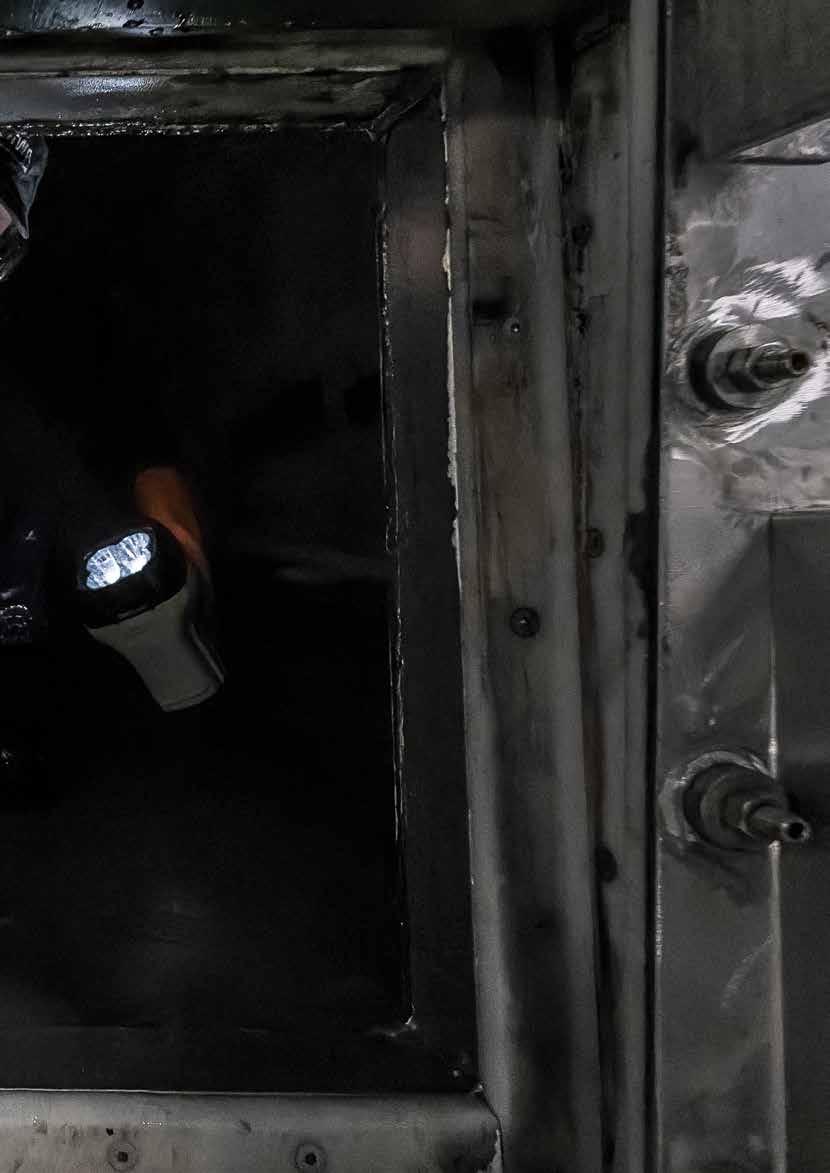
OUR PEOPLE
Environmental Monitoring Technician Jeremy Rutherford at Mount Mahanga, near the Nelson Lakes, working on one of NIWA’s 100+ weather stations. [Alec Dempster]
At the forefront of national and international scientific enquiry, delivery and innovation, our people are the key to answering some of the most pressing issues of our time.
Continuing our full commitment to health and safety
Health and safety remains a top priority, with a focus on ongoing continuous improvement building on the fundamentals of our health and safety management system. During the year there was a significant need to respond and adapt to emerging business needs in the changing COVID-19 requirements. We also refreshed our project health and safety plans and created a visual dashboard of incidents to further improve root cause trend analysis. Fieldworker safety was enhanced by additional satellite-enabled field communication devices, and working with a third-party, real-time, tracking and communication platform, and integrating it with ‘Trip Planner’ – our online emergency notification tool – enabled a nationwide view of fieldworker locations and intentions.
Attracting and retaining talent
Over the course of the year, 10 new permanent positions were approved to meet the demand for our scientific services and the required support. Retention remained strong, despite increasing competition for skilled talent. We apply best practice principles and methods during our recruitment and selection, with a thorough selection process being undertaken for all appointments. New staff receive an in-depth induction covering generic and job-specific information to provide a supportive and welcoming experience. A 3-month post-entry interview checks on early experiences to ensure new staff are well-settled. We also continually review the induction process to ensure its relevance, quality and consistency.
Ensuring positive employment relations, engagement and collaboration
We are committed to the good employer requirements of Section 118 of the Crown Entities Act 2004, and our People & Capability practices and policies are consistent with the fair and proper treatment of staff in all aspects of their employment. Engagement between management, employees and employee representatives regarding workplace practices and policies is ongoing. Early in 2022 Executive Team members met staff at each of our main sites to reconnect after the COVID-19-related travel restrictions, provide an update on key organisational priorities and objectives and engage with staff on topical issues. Our property development programme continues to provide an opportunity for staff engagement to facilitate ongoing constructive partnership on this multi-year project. A NIWA-PSA Pay Equity Working Group was established to share perspectives and ideas on gender and ethnic pay equity within NIWA, consistent with the government’s Kia Toipoto action plan.
A southeasterly and temperatures of 2 degrees failed to deter 21 NIWA Wellington staff leaping into the harbour to mark the midwinter solstice on 20 June. [Mia Blyth]
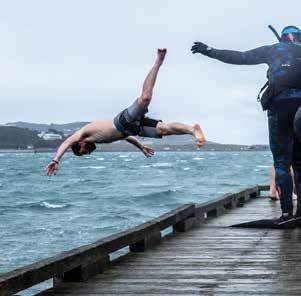



The NIWA-Nippon Foundation Tonga Eruption Seabed Mapping Project team comprised marine biologists, biochemists, geologists, technicians and students, pictured here with Tangaroa crew members on the transit home to Wellington from Tonga. [NIWA-Nippon Foundation TESMaP/Rebekah Parsons-King]
Facilitating talent development
Our annual workforce planning process considers capability and capacity requirements for our science and support staff in light of market and workforce dynamics. Succession plans are reviewed, and talent acquisition and transition plans are established in relation to staff signalling departure. High-potential and high-performing staff are identified, along with those requiring additional support to lift their performance to required levels. This sets the broader context for annual Performance and Development Reviews and half-year Progress Reviews, where managers and team members come together to review performance and development objectives, agree new objectives, discuss accomplishments and consider career development aspects. We prioritise investment in continual professional development of our highly skilled and educated workforce. A range of in-house leadership and management workshops are offered annually, including Recruitment & Selection, Developing Others, Crucial Conversations, Personal Effectiveness, Mental Health Awareness, and Challenge of Change – Resilience. A variety of other seminars and workshops are also offered across the regions. Most staff receive three personal development leave days per year to undertake activities to enhance their wellbeing and broader personal development. Developing effective senior leaders
The Senior Leadership Development Programme is now in its second year. Our focus includes personal effectiveness, coaching, emotional intelligence, strategic thinking and bicultural competency. Participants in the 3-year programme experience psychometric assessment, 360 degree feedback, peer coaching, mentoring from senior leaders, action learning opportunities, and discussions of contemporary leadership literature. A new cohort of 12 leaders began their programme in February 2022. Facilitating diversity and inclusion
In addition to work in previous years aimed at improving awareness of our existing policies, guidelines, and practices, we developed an Understanding Gender Dynamics in the Workplace training module for managers to underpin the principles of fairness, equity and non-discrimination in employment. This supports an online training course on Unconscious Bias we offer to all staff through the Digital Learning Hub, which has been refreshed and expanded to five modules.
General Manager, Science Dr Rob Murdoch (L) and Chief Executive John Morgan ( R) with two of the Science New Zealand Team Award winners, forecasters Nava Fedaeff and Ben Noll. [Stuart Mackay]

In the spirit of maintaining a constructive and professional working environment, we continue to train staff as contact people to support our Unacceptable Behaviour Policy & Resolution Process, to be available as a first point of contact if others require assistance. We remain committed to improving awareness of family violence and ensuring staff who may be impacted by family violence are safe and supported in the workplace, providing training for contact people and managers, and promoting access to SHINE, a specialist family violence support organisation. We provide a family-friendly workplace, with flexible start and finish times, part-time working arrangements, and opportunities for hybrid working arrangements, where appropriate, on a case-by-case basis to help staff balance personal and work commitments.
Prioritising employee wellbeing
We continued to prioritise employee wellbeing in another year marked by ongoing adaptation to the COVID-19 pandemic. Managers are the primary point of connection and support for staff – helping their teams bolster resilience, identifying and mitigating risks, and connecting staff who need support with appropriate services. During the 2021 lockdown a single-page guide and a ‘Korero Cards’ resource was developed to help managers have conversations about wellbeing during virtual meetings, and a ‘random coffee catch-ups’ initiative promoted conversations and connections across the wider organisation.

Kararaina Te Puni and Melanie Mayall-Nahi started their careers at NIWA as part of our Te Kūwaha graduate programme. [Rebekah Parsons-King]
NIWA PHOTOGRAPHY AWARDS Sunrise after the storm Best Phone Photo Award Winner – Svenja David
The simple scene of dosinia shells on the beach in Mount Maunganui was turned into something striking and dramatic with the clever use of the low angle shot, which the judges said created an exaggerated perspective and deep sharpness.

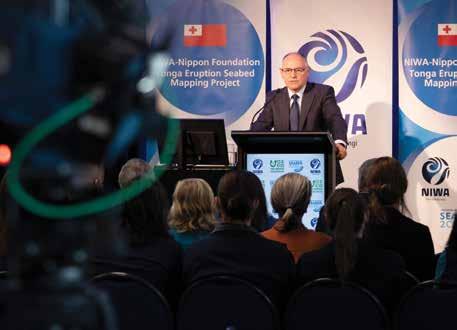

From a physical wellbeing standpoint, we offer opportunities including workstation assessments, free on-site skin checks, manual handling training and flu vaccinations for all staff. The People & Capability team continue to maintain the intranet Wellness Hub with a range of physical, mental, financial and social wellness resources.
Recognising, rewarding and celebrating our people
This year we celebrated 32 science level promotions, which follow a comprehensive peer review process and represent years of practical application and knowledge development. Our remuneration framework includes regular internal and external benchmarking to ensure staff are fairly remunerated. We continue to apply the Living Wage as the minimum across the organisation. The annual NIWA Excellence Awards recognise outstanding performance across 12 categories, and the annual staff photography competition has 6 award categories. Developing future talent
We maintain a lead role in online national and international conferences, workshops and working groups. Staff showcased NIWA expertise and collaboration, held chairing roles, presented keynote addressess and contributed to international councils and advisory groups – with about 220 staff attending 51 international and 46 domestic conferences. Fourteen staff attended international forums in person in the later months of the financial year. In addition, more than 100 scientific workshops were run or attended by NIWA staff, including research and strategy co-development with stakeholders, education and training, project partnership, and knowledge and tool-sharing. Workshops were held with local and central government agencies, utility companies, iwi/hāpu, Pacific Island entities, conservation agencies, consultancies, commercial clients, other Crown Research Institutes, sub-contractors,
Members of NIWA’s Board and Executive inspecting the recirculating aquaculture tanks under construction at the Northland Aquaculture Centre. [Lana Young] farming, dairy and irrigation industry groups, and international and United Nations parties. Our people held a range of key advisory roles and secondments, including seven staff seconded to government agencies and stakeholders. We supervised 67 PhD, 28 Masters and 4 Bachelor students nationwide (many hosted on our sites), and financially supported 4 postdoctoral and 15 PhD positions. Trainees from the Pacific Islands and other countries were hosted and trained via virtual workshops, and a range of science visitors, interns and students were also hosted, including four Te Kūwaha interns and five BLAKE Ambassadors working on science projects alongside NIWA staff. Seven staff held appointments with New Zealand universities (five with the University of Auckland, one with the University of Otago and one with Victoria University of Wellington) and many others hold adjunct roles. We continue to support the major school science and technology fairs in Auckland, North Harbour, South and East Auckland, Waikato, Bay of Plenty, Wellington and Canterbury-Westland, as well as eight regional fairs, through sponsorship, promotion and staff involvement in judging and award ceremonies.
BLAKE Ambassadors Spencer Potbury and Shannon Bentley spent two weeks at NIWA in January learning first-hand about aquatic pollution treatment. [Rupert Craggs]
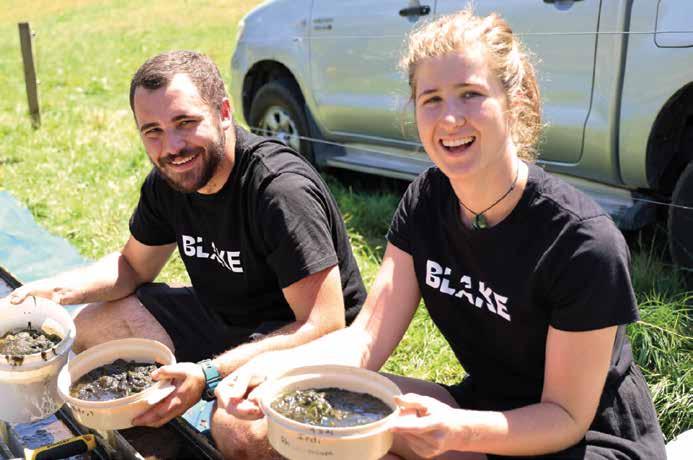
OUR PEOPLE | NIWA 2022 NIWA PHOTOGRAPHY AWARDS Crayfish party Our Work Award Winner – Irene Middleton
This image of red rock lobsters congregating below black coral was taken in Doubtful Sound, Fiordland. The judges enjoyed the great use of colour and the attitude of the crayfish – looking like they were ready to defend their rock from inquisitive photographers.
